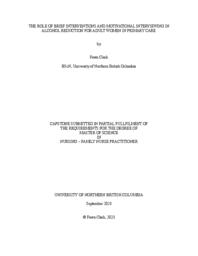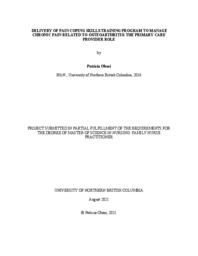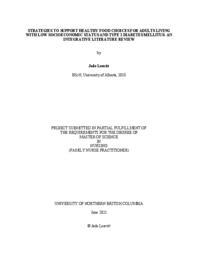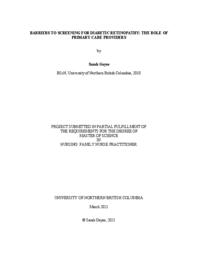Irving, Lauren
Person Preferred Name
Lauren Irving
Related Works
Content type
Digital Document
Description / Synopsis
Alcohol use is a widely accepted part of Canadian society, however the prevalence of use among Canadian women is increasing. Evidence supports that long-term alcohol related risk and harms escalate more dramatically and at lower doses than that of men, yet research is limited on appropriate interventions for adult women not otherwise captured within obstetric care. Although adult women are frequent users of primary care, screening, and early intervention for problematic drinking is lacking. The purpose of this integrative review is to appraise the existing evidence to determine the role of brief interventions and motivational interviewing in reducing alcohol consumption for adult women in the primary care setting. Recent guideline updates in Canada’s Guidance on Alcohol and Health (Paradis, 2023) to reduce health impacts of alcohol on women, as well as the sex and gender related factors that contribute to health effects of alcohol on women demonstrate the importance of prevention and early intervention. Brief interventions and motivational interviewing have shown limited effectiveness for improving awareness of health effects of alcohol on women and reducing alcohol intake in a patient centered care model. Further research is recommended to improve the quality of evidence and generalizability of practice standards of alcohol use health care related to adult women for primary care providers such as nurse practitioners, family physicians and other allied health professionals.
Origin Information
Content type
Digital Document
Description / Synopsis
Point-of-care ultrasonography (POCUS) is the process of operating a compact ultrasound machine at a patient’s location and immediately integrating the images generated into patient care. POCUS can help nurse practitioners (NPs) make more accurate diagnoses, facilitate safer procedures, and bridge health care access gaps in resource-limited settings such as primary care; however, it is widely agreed that POCUS is operator-dependent and that appropriate education is required to competently operate the device. This integrative review sought to determine what education NPs need to competently operate POCUS in primary care and it was found that there is no data specific to NPs; much of the available information is instead within the medical literature. Given the numerous benefits of POCUS for improving patient care and health care systems efficiency, NPs must urgently determine their POCUS education needs as they have ethical and legal obligations, in addition to a professional responsibility to ensure safe, high-quality patient care.
Origin Information
Content type
Digital Document
Description / Synopsis
Osteoarthritis (OA) is the primary form of arthritis that affects a large portion of the Canadian population. With expected increases in OA prevalence over time, the magnitude of outcomes related to inadequate pain control will place further burdens on society and healthcare resources. Pain Coping Skills Training (PCST) is an intervention protocol derived from cognitive behavioural therapy and has traditionally been delivered by clinical psychologists to manage chronic pain related to OA. However, few providers in the primary care setting are trained in PCST. The lack of trained primary care providers creates a barrier to patient access in the community setting, which should be addressed. An integrative literature review has been conducted to identify if primary care providers, who work in primary care settings, can deliver PCST interventions to decrease pain interference and improve quality of life outcomes in adult patients diagnosed with OA. The results are discussed within the context of Canada's primary care practice. Eleven articles were reviewed using Whittemore and Knafl’s approach to the integrative literature review. The results suggest that PCST interventions are both practical and possible among providers that do not possess a background in mental health specialization. Thus, primary care providers are encouraged to obtain educational competency to deliver this effective therapy to manage the adverse psychological effects on chronic pain related to OA. This way, providers can offer a biopsychosocial approach in managing OA while also playing an essential role in improving access to PCST interventions in the primary care setting. Recommendations for facilitating the uptake of PCST interventions are discussed, and specific strategies for its use in primary care are presented.
Origin Information
Content type
Digital Document
Description / Synopsis
Type 2 diabetes mellitus (T2DM) is an increasing concern in Canada, with low socioeconomic status being a major risk factor. This review explores strategies to improve food access that promote healthy food choices among people experiencing food insecurity and living with T2DM. Whittemore and Knalf’s (2015) integrative literature review methodology was used to extract and analyse the evidence. Four key strategies emerged: 1) promoting healthy food affordability through incentives and disincentives, 2) understanding effective and ineffective food interventions, 3) enhancing nutritional education in the standard of care, and 4) manifesting empowerment through self-efficacy and diabetes management. These strategies can be applied by nurse practitioners within primary care. Aligned with a population health approach, they can direct practice, education, and research through healthy public policy focused on reducing the incidence of T2DM, particularly in people experiencing food insecurity.
Origin Information
Content type
Digital Document
Description / Synopsis
Anxiety is a mental health condition affecting adolescents with negative side effects and consequences. Primary care providers are faced with a growing number of visits related to adolescent mental health and must be comfortable in assessing and treating the negative symptoms associated with anxiety. With the potential for anxiety to begin in adolescence and worsen in adulthood, a thorough search of the literature was completed to determine ways to help adolescents manage negative symptoms associated with anxiety and improve their coping skills. Mindfulness has been gaining popularity within the mental health community and therefore was chosen as the area of focus to determine how the implementation of mindfulness-based interventions in primary care could alleviate negative symptoms associated with adolescent anxiety. Upon completing the literature review, eight studies were chosen that highlighted how various care providers effectively delivered mindfulness interventions for adolescents experiencing anxiety, primarily within school and outpatient mental health settings. These studies showed trends related to positive effects including improving adolescent anxiety and improvements in other areas of the adolescents’ lives. Additionally, it was found that it was important for primary care providers to reinforce the importance of using a supportive approach including parents or caretakers as this was shown as a protective factor. Although there were no specific studies introducing mindfulness within adolescent primary care, a list of recommendations was developed to provide evidence-based rationale towards integrating mindfulness-based interventions within primary care. By doing so, this provides a foundation for mindfulness-based interventions that primary care providers can utilize to support adolescents in managing their negative symptoms associated with anxiety.
Origin Information
Content type
Digital Document
Description / Synopsis
Diabetes is a serious health concern that affects millions of people world-wide. The comorbidities and complications of diabetes are complex and require awareness within the healthcare system. Diabetic retinopathy affects a significant number of patients living with diabetes. Early detection through screening is recognized as the standard of care, in order to assess and monitor for diabetic retinopathy progression. Unfortunately, screening services are not always accessed, especially within the suggested time frames and frequencies. Currently there is limited data regarding the barriers that exist for individuals to access these crucial screening services. An integrative literature review approach was conducted to answer the research question: What strategies can nurse practitioners in the primary care setting use to promote screening for people living with diabetes to reduce their risk and progression to blindness from diabetic retinopathy? Four themes emerged from the findings which provided insight into determinants that affect diabetic retinopathy screening adherence: structural barriers to care, socioeconomic conditions, emotional barriers to accessing healthcare, and knowledge deficits. Discussion of three recommendations for primary care practice focus on: reassessing screening methods and intervals, activity sharing, and providing education. Implications for future research to enhance patient care are outlined.
Origin Information
Content type
Digital Document
Origin Information
Content type
Digital Document
Origin Information
Content type
Digital Document
Origin Information









